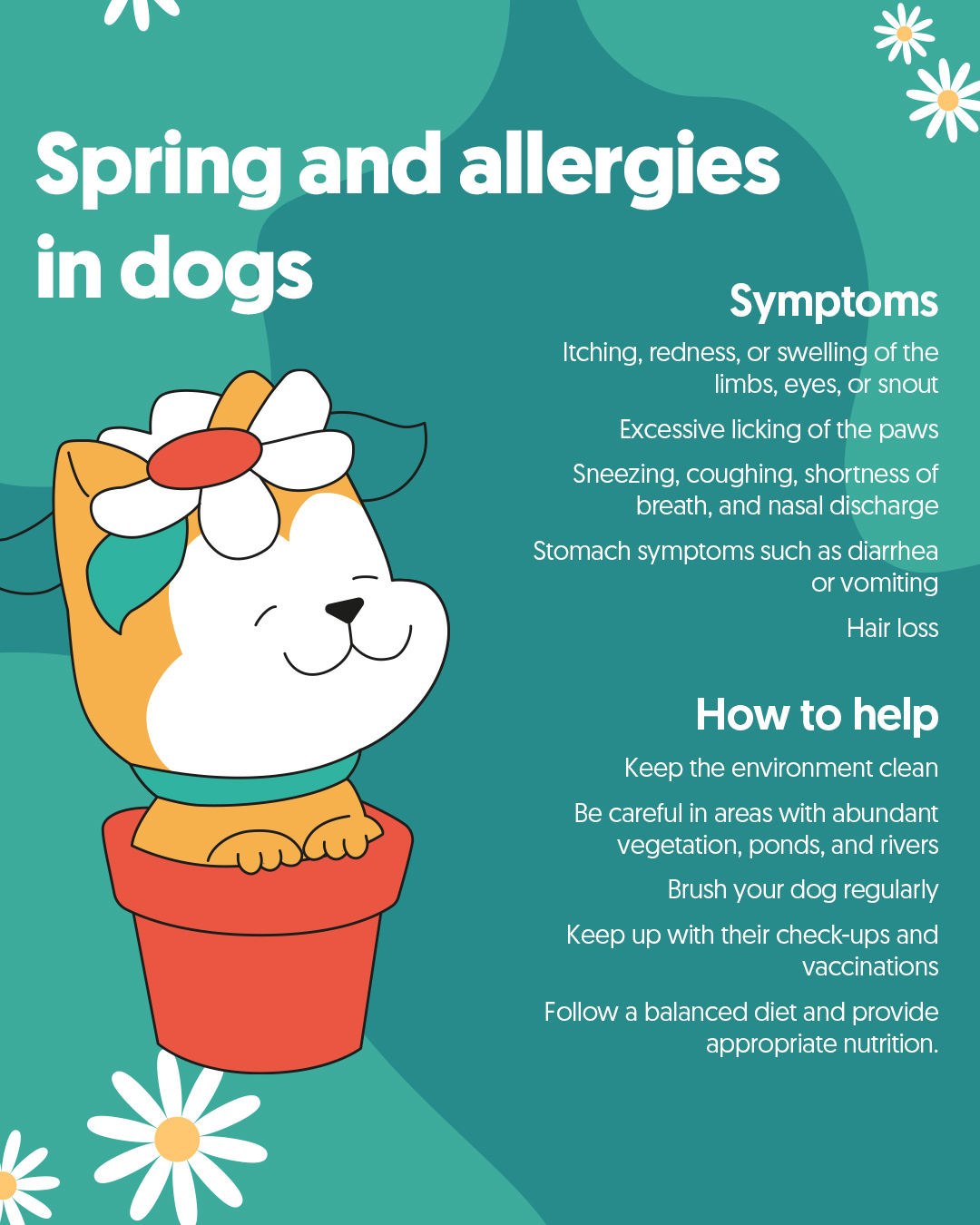The arrival of spring means the beginning of allergies, not only in humans but also in dogs, although it is less known, it is quite common.
That’s why we’re providing tips on how to deal with allergies in dogs. By doing so, we can make things easier for both you and your furry friend if they suffer from seasonal or other types of allergies.
Don’t be fooled! Even if you think that dog allergies do not affect you because your dog does not suffer from them, it’s worth reading on. Did you know that the vast majority of dog owners are unaware that their dogs have environmental or food allergies?
Types of allergies in dogs
Firstly, let’s differentiate between the types of allergies in dogs. You may notice an abnormal reaction in your dog and wonder if they might be allergic to something. But what exactly? It’s not the same to have an allergy to pollen as it is to have one to something they have eaten.
- Environmental allergy or external allergens – This is the one that should concern us the most with the arrival of good weather, spring, and heat. It’s an allergy to environmental factors that are specific to your dog’s surroundings, such as pollen, mites and dust, insects or fungi, fleas, plants or herbs, perfumes or cleaning products, etc.
- Food allergy or internal allergens – It appears after ingesting a particular product or food. The most common food allergies are practically the same as in humans (we’re not that different after all!): wheat and barley, lactose, animal protein (chicken, beef, and ox), plant protein (soy), egg, etc.
Common symptoms of allergies in dogs
According to popular belief, the only thing dogs lack is the ability to speak. However, we believe that they are perfect just the way they are. Nevertheless, we must be attentive to possible signs of allergies in dogs since they cannot tell us when they feel unwell, itchy, or uncomfortable. The most common symptoms of allergies in dogs include:
- Itching, redness, or swelling of the extremities, eyes, or snout. This can cause redness in areas near the eyes and ears, paws or pads, and swelling in joints and facial areas such as the ears and snout.
- Excessive licking of the paws. If you notice your dog persistently licking a certain area of their body, such as their paws and pads, it could be a sign of a possible allergy.
- Sneezing, coughing, difficulty breathing, and nasal discharge. These symptoms are often related to seasonal allergies to pollen, plants or herbs, and dust, mites, or fungi.
- Stomach symptoms such as diarrhea or vomiting. These are often associated with food allergies.
- Hair loss. This can be partial, causing some baldness, or uniform. In any case, if you notice that your dog is losing more hair than usual for the time of year (remember the necessary shedding that occurs in spring), consult your veterinarian.

How to help my dog if it suffers from an allergy
When it comes to allergies in dogs, it’s important to follow the advice of your veterinarian. However, there are some guidelines you can keep in mind that will help your dog feel better if they suffer from allergies:
- Keep the environment clean at all times. Wash your dog’s bed and bowls frequently, as well as their leash, collar, or harness. Don’t let too much dust accumulate in the areas where your dog spends time.
- Special attention while walking. Be especially careful when walking your dog in areas with abundant vegetation and bodies of water, such as ponds or rivers, during the warmer months. This is where parasites, fleas, and ticks tend to congregate and can “attack” your allergic dog.
- Brush your dog regularly. Their coat can accumulate many external substances that may affect their allergy. Brushing will help remove these substances and keep them clean and happy!
- Follow their vaccination schedule and take them for regular check-ups with the veterinarian. Also, remember to deworm them once every 3-4 months.
- Provide them with a balanced diet and food that meets their specific needs. If your dog has allergies, you must pay special attention to their diet. There are hypoallergenic foods with hydrolyzed proteins and natural foods that can help reduce your dog’s allergy symptoms. Always seek the advice of a professional. Your dog’s health is at stake!
How to detect allergies in dogs
Don’t panic! An allergy in dogs is simply an immune response to factors that their body considers dangerous. Therefore, it’s an indication that your dog’s immune system is working wonders.
If you notice any of the aforementioned symptoms, visit your vet. They will examine your dog and, if deemed appropriate, carry out a study to detect possible allergens that their body might be reacting to.
This study is very similar to the one conducted on humans and usually consists of one of the following tests:
- Elimination method for food allergies. This involves removing from the diet the components suspected of causing the allergy, typically by offering hypoallergenic food for a period of time.
- Intradermal test. The famous ‘allergy tests,’ which involve injecting the possible allergen into the dog’s skin and observing their reaction.
- Blood analysis. This helps distinguish which antibody your dog’s body is producing, thus concluding which allergen is causing the response.
An allergy in dogs often causes discomfort and lethargy, which can affect their well-being and quality of life. Now that you know all this, whenever you suspect your dog might have an allergy, go to your vet to look for the causes and start the appropriate treatment.
What is Gudog?
Gudog is the easiest way to find & book the perfect dog Sitter. Thousands of loving Sitters are ready to care for your dog like family! All bookings come with Veterinary Care & Free Cancellation.
